ESA: Work Capability Assessments, Mandatory Reconsiderations and Appeals: December 2021
Published 9 December 2021
Applies to England, Scotland and Wales
The latest release of these statistics can be found in the collection of ESA: outcomes of Work Capability Assessments statistics.
This is a summary of National Statistics on the outcomes of completed Employment and Support Allowance (ESA) Work Capability Assessments (WCA). The publication covers information on both initial and repeat ESA assessments in Great Britain.
This release includes:
- WCA outcomes of initial and repeat WCAs to end of June 2021
- WCA outcomes of completed Incapacity Benefit (IB) reassessments up to June 2021
- Completed initial WCA appeal outcomes for ESA claims with a start date to September 2020
- End to end initial ESA claim clearance times to end of June 2021
- Mandatory Reconsideration (MR) information to end of October 2021:
- (i) number of MR registrations
- (ii) number of MR decisions
- (iii) MR outcomes by type of decision
- (iv) Median MR clearance time
Figures for this release reflect the disruptions caused by the Coronavirus (COVID‑19) pandemic. It should also be noted that Universal Credit (UC) has now replaced income-related ESA for most new claimants and this is changing the volume and characteristics of ESA WCAs, MRs and appeals.
1. Main stories
The statistics show:
-
in the quarter to June 2021, the number of completed ESA WCAs with a DWP decision is 35,000, a decrease of 8% from the 38,000 in the previous quarter to March 2021
-
of the total number of ESA WCAs completed in the quarter to June 2021, 56% were initial WCAs (19,000) and 44% were repeats (15,000)
- in the quarter to June 2021 the majority of DWP decisions for initial WCAs resulted in a Support Group (SG) award (57%)
- the number of monthly registered MRs relating to an ESA WCA decision has remained low, standing at 380 in the month to October 2021
- the median time taken to clear MRs in the month to October 2021 is 10 days
- the median end-to-end clearance time for initial ESA WCAs is 150 days in June 2021, which marks the highest median end-to-end clearance time in any month since September 2015
2. What you need to know
The sources of the statistics are:
- DWP’s benefit administration datasets including MR data
- Healthcare provider assessment data
- HM Courts and Tribunals Service (HMCTS) appeals data for completed appeals
Information is only available for claims that began at least 6 months following the assessment date, or 9 months following the date of claim. This is because of the time required for the customer journey to end and for the information recorded to be as complete as possible.
All figures in this release have been rounded according to DWP rounding policy, as detailed in section 11.
COVID-19 operational easements
Figures for this release reflect the disruptions caused by the Coronavirus (COVID‑19) pandemic, which has led to changes to operational procedures. Such changes were necessary to process claims and ensure people in need of financial help could access benefits, while keeping customers and staff safe.
DWP temporarily suspended face-to-face health assessments from 17 March 2020 while paper-based assessments continued.
Telephone assessments were introduced from 7 May 2020. Initially only SG outcomes were possible, the full range of outcomes were available from February 2021.
Face-to-face assessments were resumed in May 2021 and they now take place alongside telephone assessments and a small number of video assessments. For more information of operational easements see the background information note.
The typical customer journey, prior to the COVID-19 easements, is detailed below:
-
Claimant registers for ESA - payment issued at assessment rate.
-
Claimant referred for WCA and issued the “Capability for Work” questionnaire.
-
Claimant completes and returns questionnaire.
-
Assessment Provider (AP) may conduct telephone, face-to-face or video assessment, or paper-based assessment and provides recommendation to DWP.
-
DWP makes a decision based on all of the available evidence, including the AP recommendation. Those found eligible for ESA are either placed in the WRAG, which offers support in preparing for work, or the SG if they are unable to work or complete work related activity. Those not eligible are found FfW.
-
If the claimant disagrees with this decision, then depending on the nature of the decision they will either (i) have to request an MR (before they can appeal); or (ii) be able to appeal straightaway.
Note: As a result of High Court decision in July 2020, MR has been discontinued for any claimant who, having been found Fit for Work (FfW) following a WCA would, if they appealed, be paid ESA pending the outcome of that appeal. This is known as Payment Pending Appeal (PPA). Not all claimants qualify, and it applies only to Fit for Work disallowance decisions, not decisions such as disallowance due to Failure to Return a Questionnaire or Failure to Attend a WCA.
3. Volumes of completed initial and repeat Work Capability Assessments
Most individuals who makes a claim for ESA will have a Work Capability Assessment (WCA). The WCA is used to assess whether or not a person has limited capability for work and therefore determines eligibility for the benefit. Both new (initial) and existing (repeat) ESA claimants have these assessments. Some individuals are not required to have a WCA. To find out more about those who are exempt, visit the GOV.UK website.
- Initial assessments refer to the first assessment of the ESA claim
- Repeat assessment refer to subsequent assessments after the prognosis period of first/previous assessment of the ESA claim expires
The number of completed WCA outcomes remains low in the latest quarter, with slightly more initial assessments than repeats.
Quarterly volumes of completed assessments by type of assessment, December 2008 to June 2021

Source: Stat-Xplore: ESA Work Capability Assessments under ESA WCA by Completed Assessment
Since the introduction of ESA, numbers and types of assessments have changed over the years. At first many assessments were initial and many of these related to claimants who were migrated from IB. Numbers of repeat assessments gradually increased, with these usually taking place between 3 months and 3 years after the previous assessment. From January 2014 until there was a period in which repeat assessments were supressed in order to focus on initial WCAs and manage the number of cases awaiting a decision, but numbers of repeat WCAs began to increase again when they were re-introduced in December 2015.
The number of completed ESA WCAs increased to reach a peak of 270,000 in quarter to March 2017 but has fallen since to stand at 35,000 in the latest quarter to June 2021.
The introduction of UC for most income-related new claims from December 2018 has greatly changed volumes and types of ESA-WCAs. This, together with the suspension of face-to-face assessments in March 2020 in response to the COVID-19 pandemic, has resulted in an overall downward trend in numbers of completed assessments.
Since April 2016 quarterly volumes of completed repeat WCAs had always been greater than initial WCAs. In the latest quarter to June 2021 the number of initial assessments (19,000) was slightly higher than repeats (15,000).
The overall decreasing trend in the number of assessments in recent years can be attributed to UC replacing most income-related new claims to ESA from December 2018 following the national rollout.
4. Work Capability Assessment Outcomes
After the work capability assessment, claimants can be categorised as:
- ESA Work Related Activity Group (claimant has been found to have limited capability for work (LCW) and is required to undertake and participate in work related activity to help them move towards the labour market),
- ESA Support Group (where claimant has been found to have limited capability for work and work related activity (LCWRA) and is therefore not required to undertake any interviews or work related activity), or
- Fit for work and therefore no longer entitled to ESA.
Assessment outcomes are based on the DWP decision following the Assessment Provider recommendation.
In the latest quarter a majority of initial WCA decisions result in a Support Group outcome.
Quarterly outcomes of initial WCA assessments December 2008 to June 2021 (Percentages)
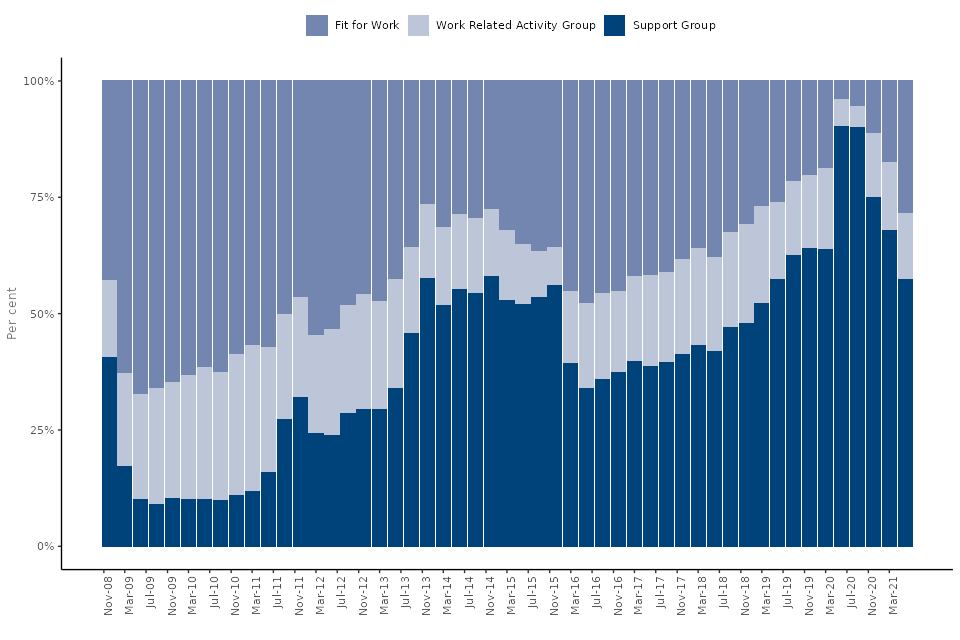
Source: Stat-Xplore: ESA Work Capability Assessments under ESA WCA by Completed Assessment
For the latest quarter the percentage of DWP decisions for initial WCAs that result in a SG outcome is 57% compared to 14% WRAG and 29% FfW. There has been a decrease of 11 percentage points of SG decisions since the previous quarter to March 2021. FfW outcomes have increased by 11 percentage points this quarter compared to the previous quarter while WRAG outcomes remained constant.
Most DWP decisions in the latest quarter for both initial and repeat WCAs result in a Support Group outcome (57% and 85% respectively).
Quarterly outcomes for initial and repeat WCAs December 2008 to June 2021

Source: Stat-Xplore: ESA Work Capability Assessments under ESA WCA by Completed Assessment
The proportions of repeat WCAs FfW have remained low despite an increase from 1% to 4% this quarter, however for initial WCAs FfW there was an increase from 17% to 29%.
For initial claims FfW was the most common outcome until August 2013, from then till February 2016 SG held the greatest share. Between February 2016 to November 2017 both track each other closely, since then however FfW outcomes have followed a downward trend, while SG outcomes have held around 50% of initial outcomes.
In contrast for repeat claims WRAG outcomes were the most common outcome from September 2009 till October 2012, since then SG has had the largest outcome share. FfW and WRAG have tracked closely however since July 2013 they have made up less than 50% of all repeat assessment outcomes, dropping to below 25% in February 2019.
The latest trends for DWP decisions on WCA outcomes are impacted by the operational changes implemented in response to the COVID-19 pandemic, such as the temporary suspension of face-to-face assessments. From March 2020 the focus was on initial assessments. Reassessments already present in the system were processed alongside those related to changes in circumstances, where possible. In May 2020 telephone assessments were first introduced, which meant that only SG decisions could be made via telephony channels. This was extended to include WRAG decisions from September 2020.
5. ESA WCA Mandatory Reconsideration registrations, clearances, and clearance times
Mandatory Reconsiderations were introduced in 2013 and if customers disagreed with a decision, they could formally ask DWP to look at it again.
The number of monthly MR registrations remains low and stands at 380 in October 2021.
Mandatory Reconsiderations registrations and clearances, October 2013 to October 2021
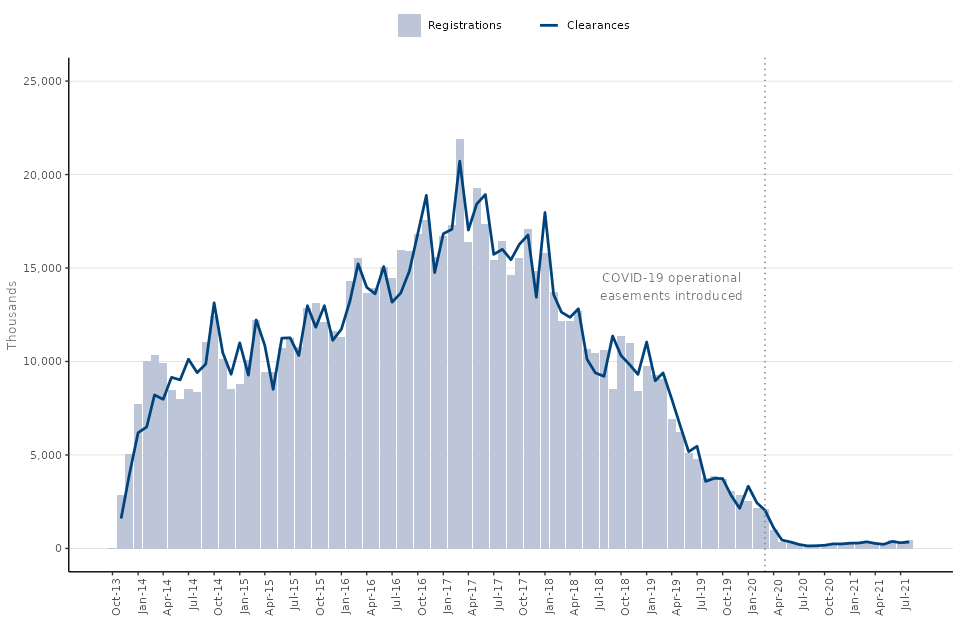
By the end of October 2021, a total of 850,000 MRs have been registered. Of these, 99.6% had been cleared. The number of MR registrations and clearances within each month fluctuate over time:
- the number of MR registrations and clearances gradually increased between April 2013 and March 2017 as volumes of ESA customers increased
- the number of monthly MR registrations peaked in March 2017 at 22,000 but have since followed a downward trend
- since May 2020 the number of MRs registered each month has remained low and has not risen significantly above 400
- there were 380 MR registrations and 460 MRs cleared in the latest month, October 2021
The number of ESA WCA MR registrations and clearances should be seen in context with the decrease of ESA claims as UC is rolled out, the changing composition of assessment outcomes, the effect of the COVID-19 pandemic and that, in some circumstances, claimants can now appeal without applying for an MR.
For the purpose of these statistics, all reconsiderations occurring after the WCA are counted as MRs. For more information on the definition of MR see section 11 of this release and the methodology note.
In October 2021 the monthly median clearance time for ESA-WCA MRs was 10 days.
Mandatory reconsiderations monthly median clearance times (calendar days), October 2013 to October 2021

Source: Stat-Xplore: ESA Work Capability Assessments under Mandatory Reconsideration – Clearances
Immediately after the introduction of MRs, in October 2013, the median average time taken to clear MRs had sharply increased to stand at 37 calendar days in May 2014. MR clearance times have significantly decreased from their peak in May 2014, and have been quite volatile since, with peaks in September 2016 (15 days), August 2018 (16 days) and January 2020 (16 days).
Since January 2020 the monthly median clearance times have fluctuated but has not risen above 14 days. In the month to October 2021, the monthly median clearance times stood at 10 days. It should be noted that these are based on very low numbers of MR clearances.
The MR average clearance times is derived using calendar days by calculating the median of the time taken from the date the Benefit Centre (BC) has decided the MR to be valid, having considered any new information, until the date the decision is cleared by the decision maker at the Dispute Resolution Team (DRT). These dates are obtained from the DWP Decision Making and Appeals Case Recorder (DMACR) reporting system. The total clearance time therefore includes the time taken to transfer the case to DRT.
6. ESA WCA Mandatory Reconsiderations outcomes
At the MR stage, there are multiple outcomes that refer to whether the Decision Maker (DM) chooses to revise the decision under dispute:
- ‘Not Revised’ – the decision the claimant is questioning has not been changed
- ‘Revised – the DM has changed the decision
- ‘Withdrawn’ – the claimant has chosen to remove their MR request
In the month to October 2021, 50% of ESA-WCA decisions were revised following an MR.
Monthly Percentages of ESA WCA Mandatory reconsideration by outcome, October 2013 to October 2021

Source: Stat-Xplore: ESA Work Capability Assessments under Mandatory Reconsideration – Clearances
From October 2013 to October 2019, more than half of requests to reconsider ESA WCA outcomes were not revised at MR stage. Since then, the proportion of assessment outcomes where the award changed after the MR gradually increased, with some fluctuation. The proportion of MR decisions resulting in a change in award rose from 53% in February 2020 to 81% in April 2020, reflecting the new operational approaches as well as COVID-19 impact.
Since May 2020 approximately two thirds of MR decisions led to a change in award. In the month to October 2021, 50% of ESA-WCA decisions were revised following an MR.
The increase in the proportion of revised decisions since 2019 should be seen in context with the large reduction in MRs, new operational approaches to gather additional oral and written evidence at the MR stage, as well as the changing composition of WCA decisions influenced by a number of factors. These include the COVID-19 pandemic and the introduction of UC replacing most income-related new claims to ESA.
Most ESA WCA MRs decisions in the quarter to October 2021 were made on disputes about ESA group allocations.
Mandatory Reconsiderations by reason for dispute for the quarter ending October 2021
| Decisions Made | Percentages (%) |
|---|---|
| Customer failed to attend WCA, provide medical evidence or return questionnaire | 9% |
| Customer disputes FFW decision | 28% |
| Customer disputes ESA group allocations | 62% |
| Others/Unknown | 0% |
Source: Stat-Xplore: ESA Work Capability Assessments under Mandatory Reconsiderations – Clearances
Mandatory Reconsiderations – Decision Outcomes for the quarter ending in October 2021
| Decision Outcomes | Revised | Not Revised |
|---|---|---|
| Customer failed to attend WCA, provide medical evidence or return questionnaire | 50% | 50% |
| Customer disputes FFW decision | 22% | 78% |
| Customer disputes ESA group allocations | 67% | 33% |
Source: Stat-Xplore: ESA Work Capability Assessments under Mandatory Reconsideration – Clearances
Note: The percentages may not sum to 100% due to rounding.
In the quarter ending October 2021, approximately 62% of MR decisions were made on disputes on ESA group allocation. Out of these, 67% of decisions made were revised in favour of the claimant.
28% of MR decisions were made on disputes against FfW decisions and 9% related to disputes where the claimant had not followed the claim procedures correctly.
7. Appeals clearances and outcomes for initial ESA claims which started up to September 2020
The claimant can dispute a DWP decision by appealing to HMCTS. Since the introduction of MRs in 2013 a customer would need to ask DWP to look at the decision again unless DWP advised that a MR was not required. Being found FfW at initial assessment is the primary reason for claimants disputing a decision. These figures focus on FfW appeals for initial assessments.
The number of appeals heard on initial FfW decisions continues to fall, reaching the lowest figure since the introduction of ESA in 2008.
Appeals outcomes on initial FfW decisions, for claims started December 2008 to September 2020
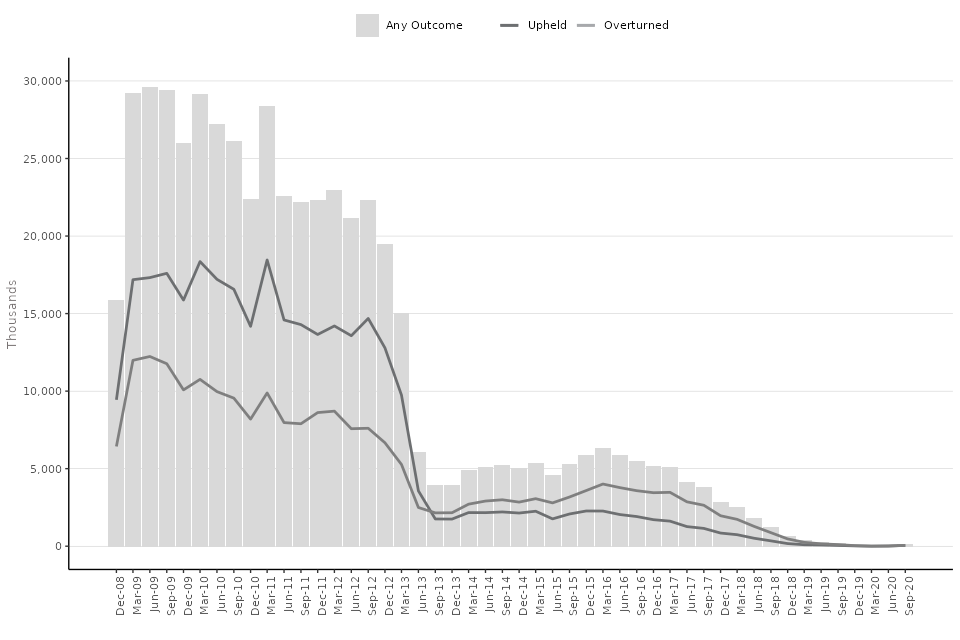
Source: Stat-Xplore: ESA Work Capability Assessments under Appeal Outcomes by Claim Start
The total number of appeals heard on FfW decisions for initial assessments up to September 2020 is very low compared to pre-2013 figures, when mandatory reconsiderations were introduced. Numbers have continued to remain lower than pre-2013 levels since MRs were introduced.
The number of appeal outcomes for claims that started in the quarter to December 2018 fell below 1,000 for the first time and have continued to fall. In the latest period, for claims that started up to September 2020, there were very few appeals outcomes. The low numbers of appeals may be partly due to the decrease in FfW decisions and an increase in MR revision rates since late 2019, which are likely to affect the number of claimants going on to appeal.
Numbers of appeals for recent quarters are too low to make any meaningful comparison.
Note: The numbers of appeals are by claim start date, therefore numbers could increase as more appeals are completed for claims started in the most recent months.
8. Health conditions and ESA group allocation for initial assessments
The health conditions recorded on the ESA claim form do not themselves grant entitlement to benefit. During the WCA, what is being assessed is the effect of someone’s health condition or disability on their capability for work, not the condition itself.
- The ESA Support Group (SG) is for those who are living with severe disabilities or health conditions which makes it unreasonable to require them to engage in work related activities
- The ESA Work Related Activity Group (WRAG) is for those claimants who the DWP consider will be capable of work at some time in the future and who they consider can take steps immediately towards moving into work (work related activity)
‘Severe functional disability’ is the main reason for SG decisions this quarter.
Main reasons for SG decisions for initial assessments by claim start date, December 2008 to March 2021
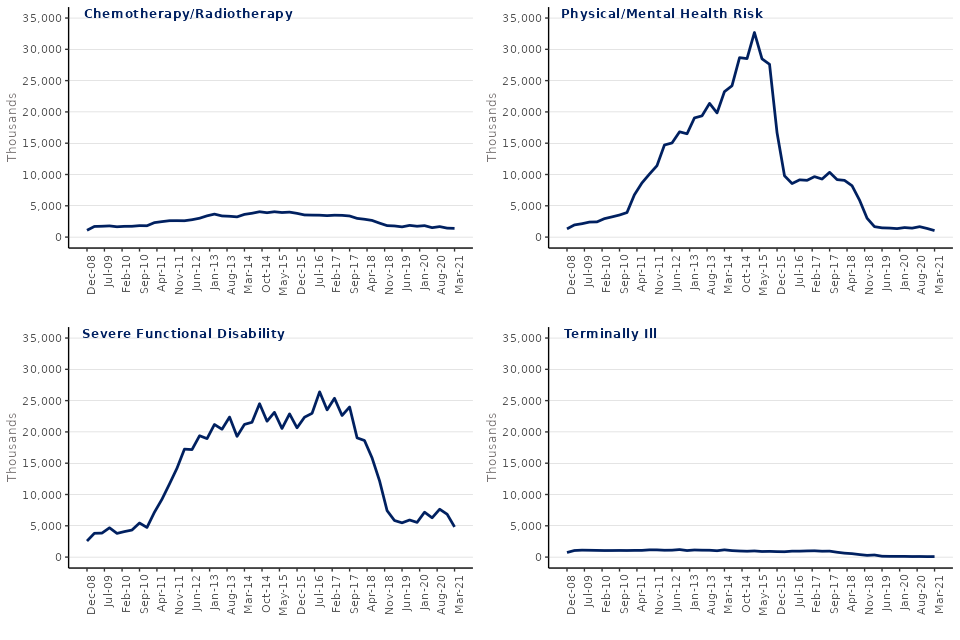
Source: Stat-Xplore: ESA Work Capability Assessments under ESA WCA by Claim Start
Note: Claimants can have multiple functional impairments, therefore appear in more than one category.
Most claimants assigned to the SG, who started their initial ESA assessment in the quarter to March 2021, were allocated SG due to health conditions linked to ‘Severe functional disability’. This accounts for 4,800 (63%) of all SG allocations this quarter. ’Severe functional disability’ has been the main reason for allocation, being over 50% since January 2016.
There was a notable decrease in allocations to the ‘Physical or mental health’ risk group for claims started from October 2015 onwards. Volumes in this group fell from 28,000 in the quarter to September 2015 to 17,000 in the quarter to December 2015. This should be seen in context with the updated guidance on the application of risk introduced at the start of 2016.
For claims started in the quarter to March 2021, 1,000 cases were allocated to the SG due to ‘Physical or mental health risk’, while 1,400 were awaiting/recovering from chemotherapy/radiotherapy and 80 were terminally ill.
Note: Since 29 September 2017, claimants in the ESA SG no longer need to be reassessed if they meet the Severe Condition criteria. Information on this can be found on Stat-Xplore.
‘Adapting to change’ and ‘Social interaction’ remain the main reasons for WRAG allocation (with 15 points or more) this quarter.
Receiving 15 points or more is the main reason for assignment to the WRAG at initial assessment. More information can be found in in background information note.
Main reasons for WRAG (15+ points) allocations for initial assessments by claim start date (percentages), December 2008 to March 2021
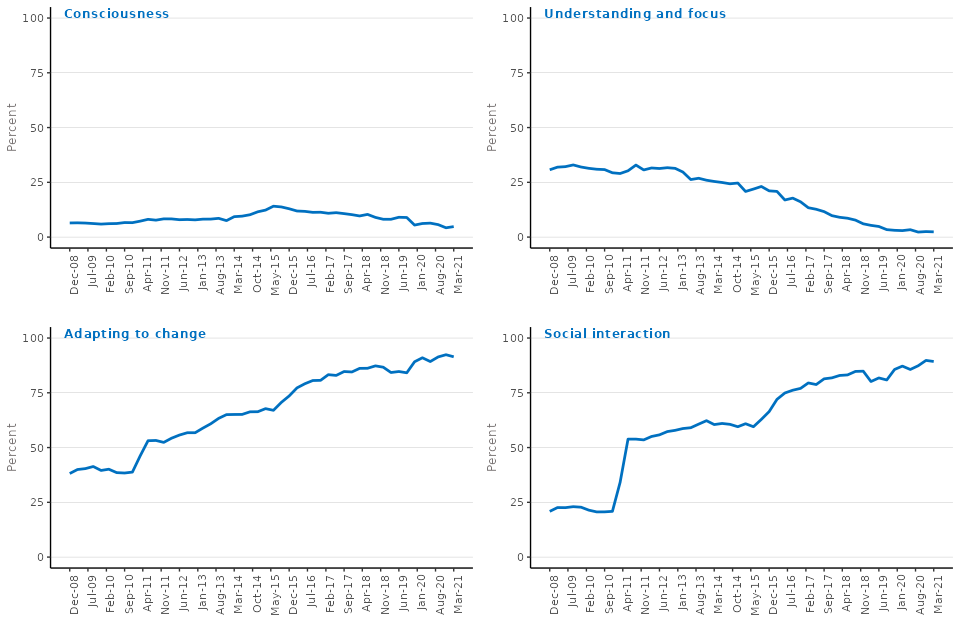
Source: Stat-Xplore: ESA Work Capability Assessments under ESA WCA by Claim Start
Note: Claimants can have multiple functional impairments, therefore appear in more than one category.
For claimants allocated to WRAG with 15 points or more, the most common categories for scoring points this quarter were ‘Adapting to change’ and ‘Social interaction’. Of these claimants, 91% had an ‘Adapting to change’ condition and 89% scored points in the ‘Social interaction’ group.
Alongside these categories, in the latest quarter, claimants with impairments relating to consciousness and understanding accounted for 5% and 2% respectively of allocation to WRAG with 15 points or more.
Other reasons for being assigned to WRAG (with 15 points or more) are less common (Upper Limb, Sensory, Continence, and Lower Limb).
9. Experimental data: Sankey showing the ESA WCA, MR and appeal process for claims starting October 2013 to March 2021
Numbers of all WCA, MR, appeals at stages in customer journey from October 2013 to March 2021

Of the 4.9 million ESA claims with a start date between October 2013 and March 2021:
- 66% had a completed assessment; WCAs for the remaining claims are either still in progress or were closed by the claimant
- 400,000 MRs have been registered, following a completed WCA
- 99.7% of these MRs, which were raised after the WCA, have been completed, with the original decision revised 17% of the time
- 26% of claimants who raised an MR after the WCA went on to complete an appeal
- of the 100,000 appeals completed, 34% had the DWP decision upheld at hearing while the remaining 66% were ruled in favour of the claimant
As a result of High Court decision in July 2020, MR has been discontinued for any claimant who, having been found Fit for Work following a WCA would, if they appealed, be paid ESA pending the outcome of that appeal. Not all claimants qualify, and it applies only to Fit for Work disallowance decisions.
10. ESA WCA customer journey clearance times for initial claims (experimental statistics)
The median end-to-end clearance time is a measure from the claim registration date to the final DWP award decision. Claim registration date is the date the claimant has first contact with the department when making a claim to ESA. The DWP decision will include MRs where there is a completed decision.
The median end to end clearance times have been following a mainly increasing trend since May 2020.
Median clearance times for initial claims: showing end-to-end clearance times and referral to assessment provider recommendation (days) October 2008 to June 2021
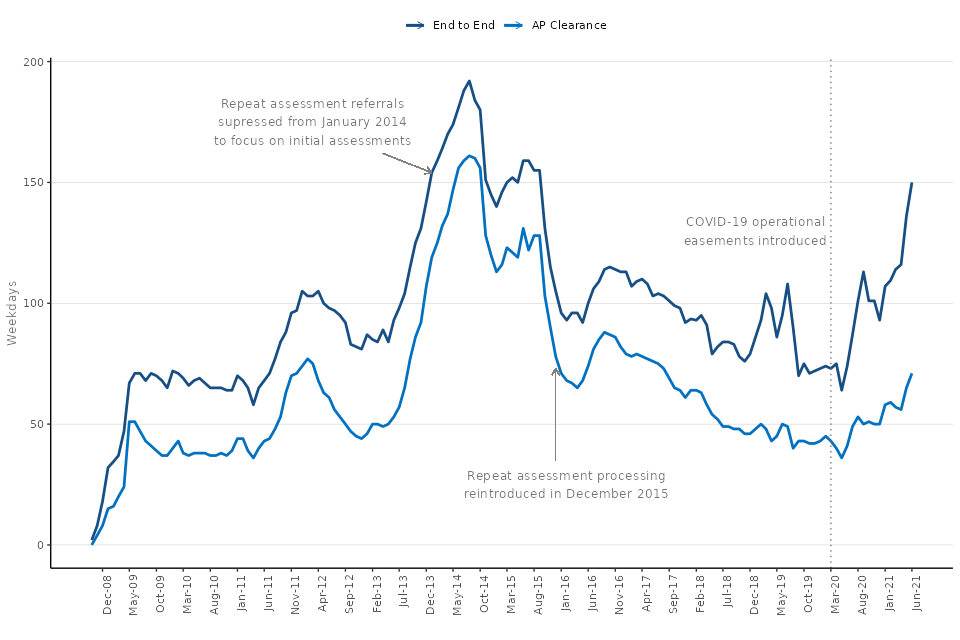
Source: Stat-Xplore: ESA Work Capability Assessments under Clearance Times for Initial Claims
After 2008, the median end-to-end clearance time generally followed an upward trend, reaching a peak of 192 calendar days in August 2014 falling to 70 days in September 2019. Since then, it has steadily increased to 150 days for the latest month, which marks the highest median end-to-end clearance time in any month since September 2015.
One of the stages of the end-to-end process accounts for the time between the customer’s referral to the Assessment Provider (AP) and the AP recommendation. This stage will usually involve a WCA assessment and includes the waiting time for the customer to complete and return the questionnaire. Multiple referrals are sometimes required before an assessment is completed and a recommendation received, as customers may not attend appointments or return questionnaires.
In June 2021, the median time between referral to the AP and their recommendation was 71 days.
Median clearance times by stage for completed initial claims since the introduction of COVID-19 operational easements (March 2020), in days, to June 2021

Source: Stat-Xplore: ESA Work Capability Assessments under Clearance Times for Initial Claims
The increase in trend is largely driven by the increases in times in the first and second stage of the claimant’s journey, that is the time between the claim being registered and being referred for assessment, and the following stage from referral to AP recommendation.
Since December 2011 until July 2020, the monthly median clearance time from claim registration to referral has remained under 10 days. In more recent months, it has steadily increased from 2 days in March 2020 to 25 days in March 2021, dropping slightly to 23 days in the month to June 2021.
There have also been increases in the time taken from referral to AP recommendation since COVID-19 easements were introduced. As a result, the median clearance time has increased from 43 days in March 2020 to 57 a year later, March 2021, and to 71 days in the month up to June 2021.
11. About these statistics
The UK Statistics Authority has designated these statistics as National Statistics, in accordance with the Statistics and Registration Service Act 2007 and signifying compliance with the Code of Practice for Statistics. This badge does not currently apply to the experimental cohort figures or ESA clearance times.
Key uses of the statistics include:
-
Providing the evidence base for assessing the potential effect of changes, monitoring and evaluation of DWP policy.
-
Answering Parliamentary Questions and Freedom of Information requests and forecasting benefit expenditure (in conjunction with expenditure statistics).
-
Policy development and evaluation by local authorities and other welfare to work and pensions stakeholders and providers.
This release only includes ESA WCAs.
This release does not capture:
- UC WCAs
- UC MRs
- UC appeals
Recent trends in these ESA WCA statistics will be affected by the roll out of UC.
Terminology
| Term | Definition |
|---|---|
| Registration | Claimant registers an application for a WCA, MR or appeal. |
| Clearance | DWP decision maker has determined whether the claimant should or should not be entitled to claim ESA. |
| Mandatory Reconsideration | Claimant wishes to dispute a decision made on their claim and requests DWP to reconsider the decision. Due to operational practices performed within the DMACR system, some MRs are recorded on the source data as ‘reconsiderations’. Therefore, for the purpose of these statistics, all ‘reconsiderations’ occurring after the WCA (for reasons typically associated with MRs) have been included within the total number of MRs. |
| MR clearance time | The clearance time begins from the point the MR is raised on the DWP administrative system by the Benefit Centre as a valid MR, having considered whether they can initially change the decision in the light of any new information. The total clearance time therefore includes the time taken to transfer the case to the Dispute Resolution Team and the time taken for the decision maker to make a decision. |
| Repeat assessment | An existing claim that has been reassessed for ESA, as opposed to a new claim. A repeat assessment is the second or subsequent WCA undertaken on an existing, continuous ESA claim, usually between 3 and 24 months after the previous assessment. These claimants will have already been assessed as having a limited capability for work at their initial WCA and the repeat assessment will assess if their capability for work has changed. |
Rounding policy
Since March 2017, the following rounding policy has been applied to the statistical release. Please note that percentages shown within the release are calculated using figures prior to rounding.
| From | To | Rounded to |
|---|---|---|
| 0 | 1,000 | 10 |
| 1,001 | 10,000 | 100 |
| 10,001 | 100,000 | 1,000 |
| 100,001 | 1,000,000 | 10,000 |
| 1,000,001 | 10,000,000 | 100,000 |
| 10,000,001 | 100,000,000 | 1,000,000 |
IB reassessments information on Stat-Xplore
Information on Incapacity Benefit (IB) reassessments is now published via Stat-Xplore.
Where to find out more
See Stat-Xplore for more detailed breakdowns of the data covering Region, Local Authority and Westminster Parliamentary Constituency breakdowns available for WCA outcomes by claim start date and completed assessment date.
Read the methodology note for more detailed information on these statistics.
Read more about ESA.
Contacts
DWP would like to hear your views on our statistical publications. If you use any of our statistics publications, we would be interested in hearing what you use them for and how well they meet your requirements.
For more information on these statistics, or to provide feedback on our publication, please email wca.statistics@dwp.gov.uk
For further enquiries, you can contact Press Office: 0203 267 5144
ISBN: 978-1-78659-375-7
